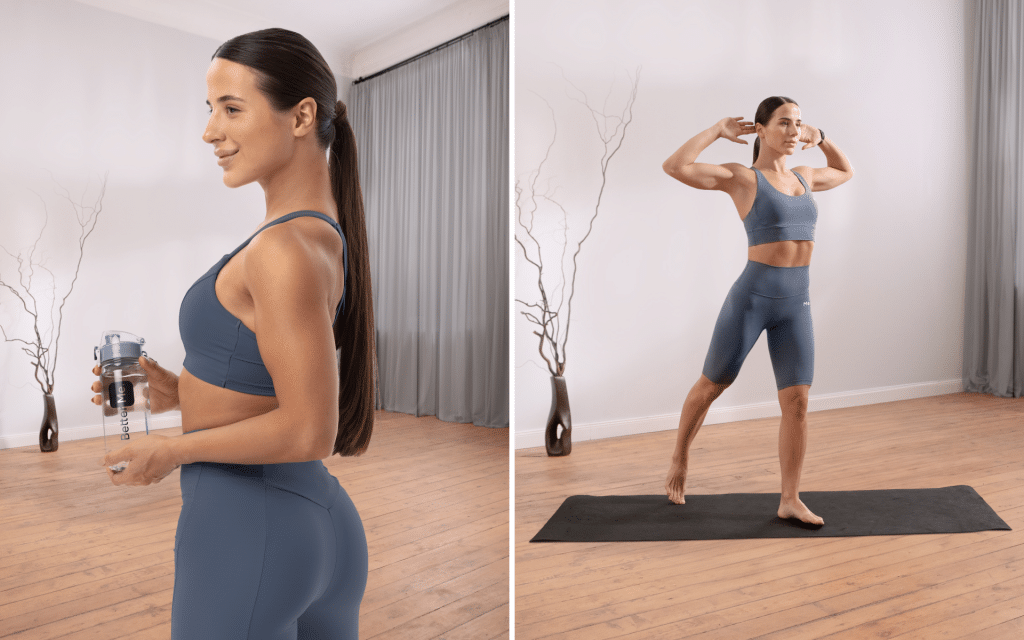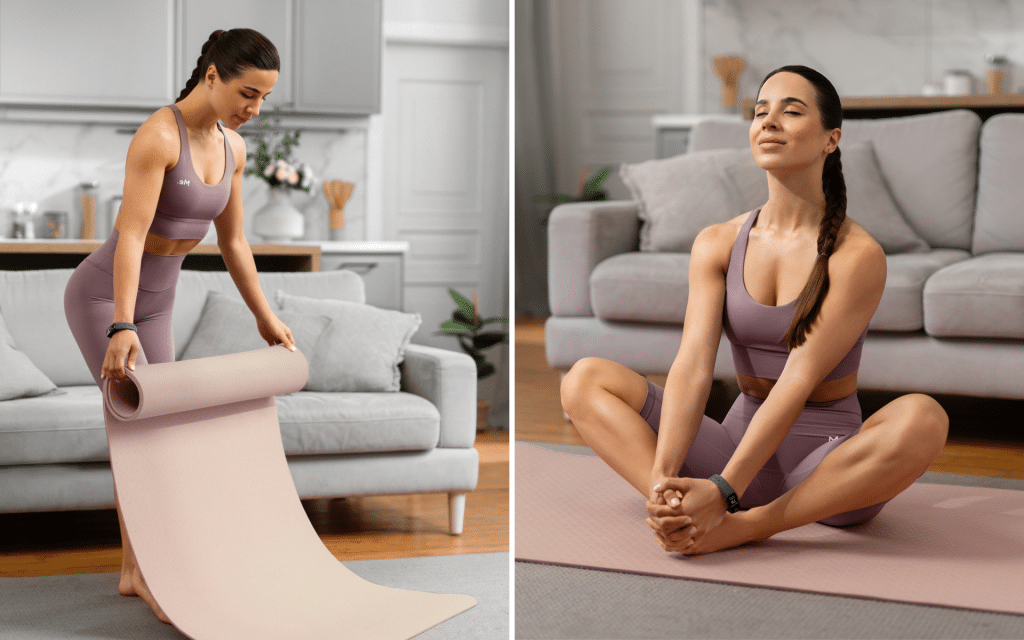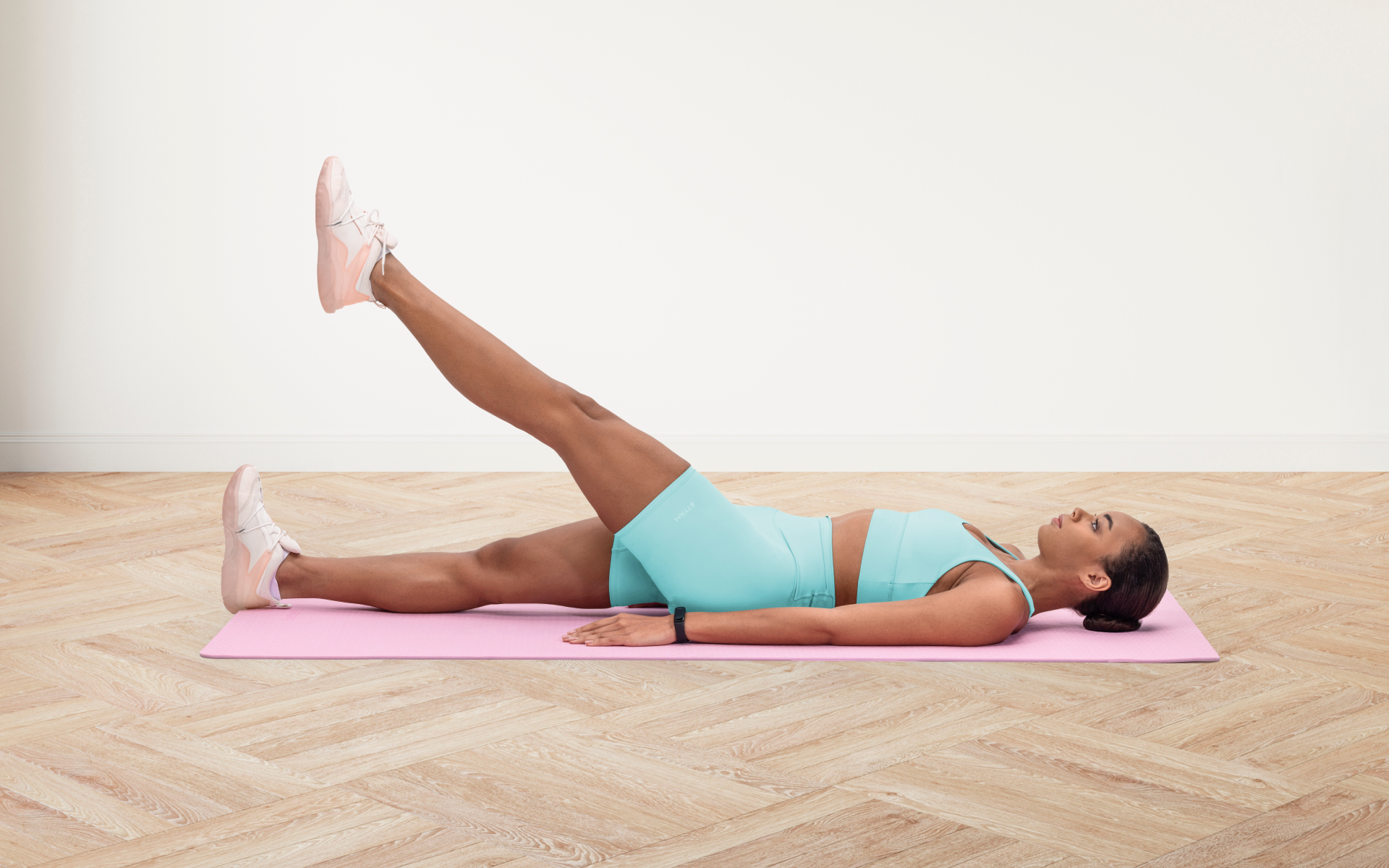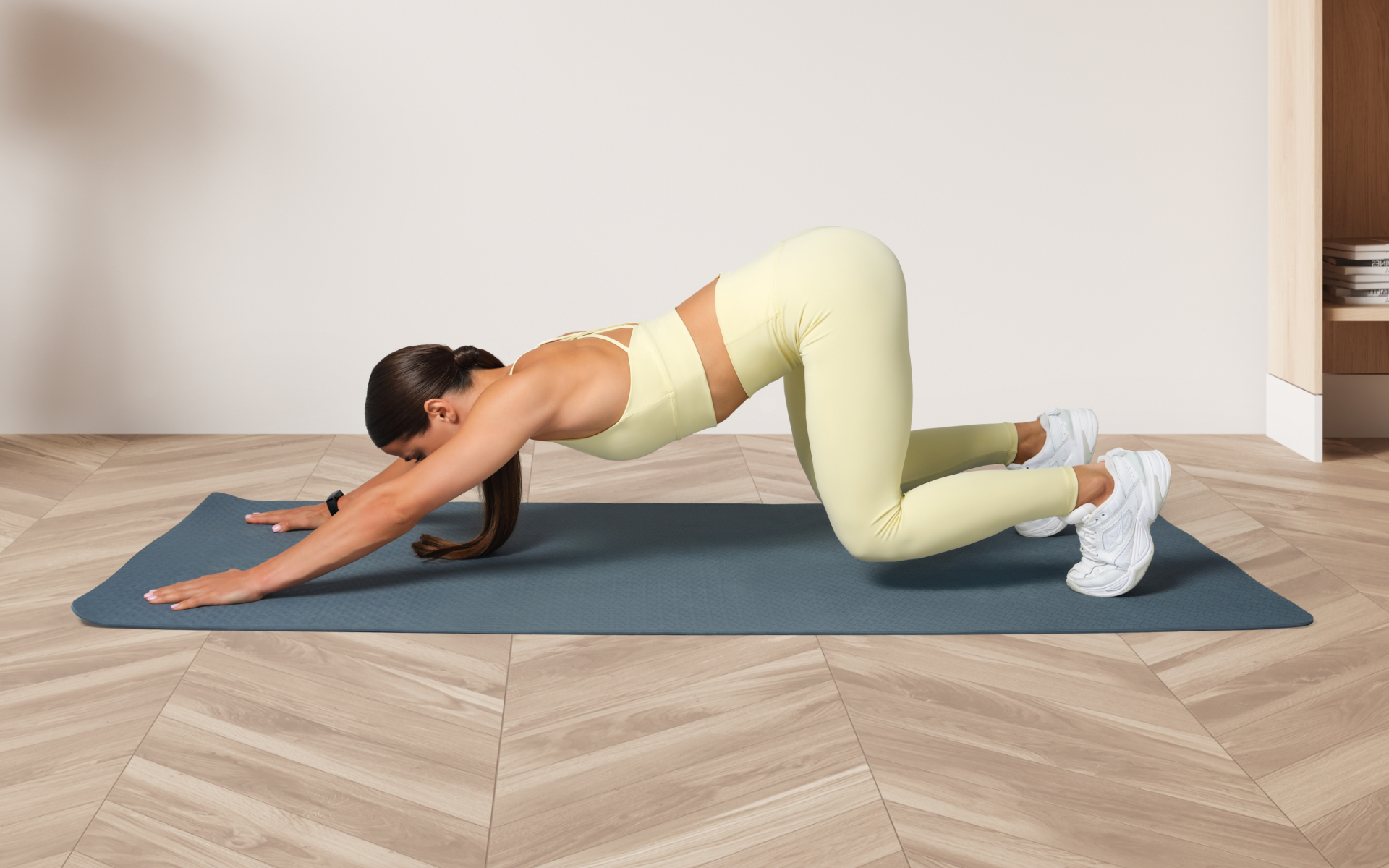The reformer was invented in the 1920s by Joseph Pilates, the founder of the Pilates method (1).
A man ahead of his time, Pilates designed the reformer to help improve strength, flexibility, and body alignment. He created it using hospital beds and springs to aid injured soldiers with their recovery, combining gentle resistance with controlled movements.
Today, the modern reformer is far more refined, but it still serves the same purpose:
Enhancing physical performance and overall well-being.
At first glance, the reformer is a sleek, bed-like frame with a platform that slides back and forth. It also features springs, pulleys, and straps that may remind you of a futuristic workout contraption.
But don’t be fooled by its complex appearance!
The reformer is one of the most effective tools for transforming your Pilates practice, offering a unique blend of challenge and support.
What are some benefits of Pilates reformer exercises?
Here you can learn more about how to incorporate a reformer into your Pilates routine to optimize your sessions:
What Are The Main Benefits Of Pilates Reformer Exercises?
Many ask the question, “What does Reformer Pilates do for your body?”
1. Enhanced Resistance Training
The reformer’s springs allow users to adjust resistance levels, making exercises progressively more challenging. Resistance comes from the springs, rather than weights, which provides consistent tension throughout each movement.
This resistance strengthens both the concentric (shortening) and eccentric (lengthening) phases of muscle contraction. Over time, this balanced approach improves muscle endurance and overall strength.
2. Improved Alignment And Feedback
The reformer provides physical feedback that helps with body awareness.
For example, the machine’s sliding carriage can highlight imbalances between the left and right sides of the body. This feedback allows practitioners to make corrections mid-movement, which can lead to improved posture and spinal alignment.
Maintaining proper alignment reduces strain on joints and promotes efficient movement patterns.
3. Customizable Workouts
You or a trainer can adapt reformer exercises to suit any fitness level.
The machine’s adjustable springs and straps allow for modification of:
- Resistance
- Intensity
- Range of motion (2).
Someone recovering from an injury might focus on gentle, low-resistance work, while an advanced athlete can add more resistance or engage smaller stabilizing muscles to challenge their control.
But always remember that individuals with previous injuries should consult a medical professional before starting any new form of exercise.
4. Greater Range Of Motion
The reformer allows you to move through an extended range of motion, increasing flexibility. Unlike mat Pilates, where the floor may limit the body, the reformer facilitates deep stretches supported by the sliding carriage. Larger, controlled movements lengthen muscles safely and help to maintain joint mobility.
5. Targeted Muscle Activation
The reformer is ideal for isolating specific muscle groups.
For example, in leg or arm stretches, the springs provide resistance that forces the stabilizing muscles, such as the core, to engage (3).
This muscle engagement ensures that muscles work synergistically, improving their function. It can correct compensations where larger muscles may otherwise dominate movements.
BetterMe: Health Coaching app helps you achieve your body goals with ease and efficiency by helping to choose proper meal plans and effective workouts. Start using our app and you will see good results in a short time.
6. Low-Impact, High-Result Exercise
Pilates on the reformer is gentle on the joints. The resistance comes from the springs, rather than weight-bearing forces.
Walking or jumping can strain knees or ankles, but with the reformer, you can strengthen muscles without placing undue pressure on those areas.
This low-impact nature makes reformer Pilates a safe and effective option for long-term fitness (2).
7. Versatility In Exercises
The reformer supports a vast array of exercises targeting different muscle groups.
You can lie, sit, kneel, or stand on the machine, allowing for countless variations.
This versatility keeps workouts engaging and ensures that every major joint and muscle group gets attention. You can choose exercises to improve power, flexibility, or endurance as needed.
8. Improved Balance And Stability
Balancing on the reformer’s moving carriage activates stabilizing muscles, especially those around the pelvis, hips, and spine.
Over time, the balancing aspect improves proprioception—your ability to sense where your body is in space—and overall stability. This stabilizing factor translates to improved performance in daily activities and even sports (4).
9. Support For Rehabilitation
The reformer’s design makes it ideal for recovering from injuries.
Its low-impact nature minimizes stress on healing tissues, while the adjustable resistance facilitates controlled strengthening.
It helps with retraining proper movement mechanics and restoring range of motion.
The reformer’s support reduces the risk of re-injury during recovery (2).
10. Mind-Body Connection
The Pilates reformer encourages controlled, deliberate movements.
To execute exercises correctly, you need focus and precision.
This focus builds a stronger mind-body connection, improving coordination (5).
Over time, this mindfulness carries over, leading to greater awareness of posture, movement, and breathing in every aspect of life.
Read more: Is Combining Yoga and Wall Pilates Ideal for an At-Home Workout?
Does Reformer Pilates Burn Belly Fat?
Is reformer Pilates good for weight loss?
We get these questions all the time.
Here’s the truth: Reformer Pilates alone likely won’t lead to significant belly fat loss.
To lose fat anywhere on your body, including your belly, you need to create a calorie deficit. This deficit means burning more calories than you consume (6).
Reformer Pilates isn’t a high-intensity, high-calorie-burning workout, so it may only result in moderate calorie expenditure.
Furthermore, the body doesn’t selectively burn fat from specific areas based on the type of exercise performed. Instead, fat loss occurs systemically, meaning your genetics play a role in determining where you store fat and which areas it comes off first (7).
Reformer Pilates places a significant emphasis on the core musculature.
The core includes the following muscles:
- Obliques
- Rectus abdominis (your “six-pack”)
- Transverse abdominis (deep abdominal muscle)
- The muscles around your pelvis and lower back (8, 9)
Many pilates reformer core exercises challenge these muscles to stabilize, rotate, and hold tension, which can lead to stronger, better-defined abs.
However, this strengthening doesn’t directly “burn” belly fat—it simply enhances the appearance of your midsection once you reduce fat levels through overall weight loss.
That said, consistently exercising tends to encourage other lifestyle changes that can promote the benefits of reformer Pilates weight loss. You’re more likely to eat a healthier diet and make better choices if you’re regularly working out (10).
So, while Reformer Pilates alone likely won’t lead to significant belly fat loss, it shines as a component of a comprehensive fitness and wellness program.
Combine it with a calorically appropriate diet, regular cardiovascular activity, and good sleep hygiene to create the conditions for fat loss (11).
The Role Of Stress And Hormones In Belly Fat Accumulation
Interestingly, Reformer Pilates may indirectly help reduce belly fat through stress management. Chronic stress can increase cortisol levels, a hormone associated with fat storage in the abdominal area (12).
Practicing Pilates focuses on controlled, mindful movement and deep breathing, which can reduce stress and help keep cortisol levels in check (13).
While this isn’t a direct fat-burning mechanism, it’s a valuable factor in managing belly fat over time.
How Many Times A Week Should You Do Pilates Reformer Exercises?
How often you should do Reformer Pilates depends on your goals, fitness level, and recovery needs. That said, here’s a general guideline for different exercise scenarios:
- Beginners: Start with 1-2 weekly sessions. This amount gives your body time to adapt to the new movements while avoiding overuse or soreness.
It also allows you to master proper form and technique.
- Intermediate to Advanced Practitioners: Aim for 2-4 sessions per week.
At this stage, you have conditioned your body to handle a higher frequency of training, and your muscles will benefit from consistent activation.
- Specific Goals:
- For general fitness, 2-3 weekly sessions provide an excellent balance.
- If you’re targeting rehabilitation or recovery, frequency depends on your physical therapist’s or doctor’s advice, often 2-3 sessions per week.
- For strength or flexibility goals, 3-4 weekly sessions can yield noticeable improvements.
It’s vital to avoid overtraining. Recovery days allow muscles to repair and grow stronger.
If Pilates is part of a broader fitness routine that also includes cardio or weight training, 1-2 sessions per week may be sufficient.
How Quickly Will I See Results From Reformer Pilates?
The timeline for seeing results from Reformer Pilates varies from person to person.
It depends on factors such as your starting fitness level, the frequency of sessions, and your overall lifestyle.
Here are the Pilates results you can expect:
- In A Few Sessions (1-2 Weeks):
- Improved posture from better alignment and core activation.
- A sense of increased flexibility, especially in the hips, back, and hamstrings
- Enhanced body awareness or feeling more “in tune” with your muscles
- Within A Month (4-6 Weeks):
- Stronger core muscles lead to better stability and balance.
- Changes in endurance and muscle tone, particularly in the abs, arms, and legs
- Reduced tension or discomfort in areas like the lower back, if previously tight or weak.
- After 2-3 Months Of Consistency:
- Noticeable strength gains across your body.
- Improved flexibility and control in movements
- A leaner appearance, especially if you’re pairing Pilates practice with a balanced diet and other exercises
- Long-Term (6 Months+):
- Significant improvements in overall strength, alignment, and body composition
- Lasting changes in posture and movement patterns from new muscle memory
Pilates is a gradual, sustainable approach. Don’t expect rapid transformations, but with regular practice and complementary healthy habits, the benefits will accumulate over time.
When it comes to weight loss, progress is made by inches, not miles, so it’s much harder to track and a lot easier to give up. The BetterMe: Health Coaching app is your personal trainer, nutritionist, and support system all in one. Start using our app to stay on track and hold yourself accountable!
Is Just Doing Reformer Pilates Enough?
Reformer Pilates is incredibly versatile and offers a full-body Pilates workout, but whether it’s enough depends on your personal fitness goals.
Here’s how Reformer Pilates can be enough or insufficient for various scenarios:
When It Might Be Enough:
- Core Strength and Stability: Reformer Pilates excels at strengthening your core and stabilizing muscles (3). It’s sufficient if core strength or posture improvements are your primary goal.
- Low-Impact Fitness Needs: If you’re looking for a gentle, joint-friendly workout, Reformer Pilates covers strength, flexibility, and balance without undue strain.
- Rehabilitation or Recovery: It can serve as a standalone program for recovering from injuries or addressing chronic pain (2).
Always contact your medical provider if you are recovering from an injury.
This professional communication is the best way to ensure that Reformer Pilates exercises will work for you.
When It Might Not Be Enough:
- Cardiovascular Health: Pilates doesn’t sufficiently elevate your heart rate for extended periods. For heart health, you’ll need to include aerobic exercise like walking, running, swimming, or cycling (14).
- Bone Density Needs: While the resistance provided by the reformer helps maintain bone density, compound exercises like squats or deadlifts offer greater benefits for preventing osteoporosis (15).
- Specific Performance Goals: If you’re training for a sport, you may need supplemental exercises targeting power, agility, or sport-specific endurance.
For general fitness, pairing Reformer Pilates with cardio and strength training creates a well-rounded plan.
If time is limited and you’re considering the benefits of Pilates reformer once a week, prioritize your goals and adjust your program accordingly.
Read more: How Does Pilates Help Your Body Function Better?
What Are The Disadvantages Of Pilates Reformers?
While Reformer Pilates offers numerous benefits, it has its limitations.
Here are some potential drawbacks to consider:
- Cost:
Reformer machines are expensive, making them less accessible for home use.
Studio classes are often pricier than traditional gym memberships. - Space Requirements:
Reformers are large and not suitable for small living spaces.
The space requirements limit at-home practice unless you have a dedicated room for the machine. - Learning Curve:
The reformer requires proper instruction to use safely and effectively.
Beginners may find it intimidating or challenging without guidance. - Limited Cardiovascular Benefits:
Most reformer exercises focus on muscle strength and control rather than cardio, so they’re not necessarily ideal for those looking to improve their heart health or burn a large number of calories quickly. - Accessibility:
Not all areas have Pilates studios offering reformer classes, which can make it challenging to access consistent training.
Yes, rest days are essential for recovery and muscle repair (16). While Reformer Pilates is low-impact, it still challenges your muscles, especially the core and stabilizers. Taking 1-2 rest days per week helps prevent overuse injuries and allows your body to rebuild stronger. Reformer Pilates can be challenging because it combines controlled movements, resistance from springs, and requires balance and precision. These factors force you to engage stabilizing muscles and maintain proper alignment, which demands both strength and focus. You may adjust the intensity, making it suitable for various fitness levels while consistently pushing your limits. It depends on your goals. Reformer Pilates focuses on strength, alignment, and controlled movements using resistance, making it an effective form of muscle conditioning (3). Yoga, on the other hand, emphasizes flexibility, mindfulness, and balance while also incorporating breathwork (17). Both are valuable, but they serve different purposes, and the better option depends on your personal needs. Reformer Pilates and HIIT are very different workouts. Pilates excels at building core strength, improving posture, and offering low-impact training (1). In contrast, HIIT is designed for cardiovascular health, burning calories, and improving endurance (18). Neither is inherently better, but they complement each other well when combined in a balanced fitness program. Choose based on your fitness objectives and preferences.Frequently Asked Questions
Do you need rest days for reformer Pilates?
Why is Reformer Pilates so hard?
Is reformer Pilates better than yoga?
Is Reformer Pilates better than HIIT?
” mp4=”https://cdn.betterme.world/articles/wp-content/uploads/2025/05/PilatesOlesia1.mp4″]
The Bottom Line
The Pilates reformer is a powerful tool for improving strength, flexibility, and overall body alignment. Its unique features allow for a tailored workout experience, catering to individuals of all fitness levels and goals.
From building lean muscle to supporting rehabilitation, the reformer offers versatility and effectiveness that are hard to match.
While it’s not a one-size-fits-all solution, the reformer shines when integrated into a well-rounded fitness routine. Whether you’re seeking to enhance your core strength, reduce stress, or simply move with more control and precision, it’s worth exploring how this method might fit into your lifestyle.
Combining your reformer practice with activities like cardio and a balanced diet will create a sustainable path toward your fitness goals.
DISCLAIMER:
This article is intended for general informational purposes only and does not serve to address individual circumstances. It is not a substitute for professional advice or help and should not be relied on for making any kind of decision-making. Any action taken as a direct or indirect result of the information in this article is entirely at your own risk and is your sole responsibility.
BetterMe, its content staff, and its medical advisors accept no responsibility for inaccuracies, errors, misstatements, inconsistencies, or omissions and specifically disclaim any liability, loss or risk, personal, professional or otherwise, which may be incurred as a consequence, directly or indirectly, of the use and/or application of any content.
You should always seek the advice of your physician or other qualified health provider with any questions you may have regarding a medical condition or your specific situation. Never disregard professional medical advice or delay seeking it because of BetterMe content. If you suspect or think you may have a medical emergency, call your doctor.
SOURCES:
- Pilates: how does it work and who needs it? (2011, ncbi.nlm.nih.gov)
- PILATES EXERCISES, TYPES, AND ITS IMPORTANCE: AN OVERVIEW (2023, researchgate.net)
- Effect of Reformer Spring Resistance Modifications on Core Muscle Activity During Basic Core Muscle Exercises (2024, ncbi.nlm.nih.gov)
- An online pilates exercise program is effective on proprioception and core muscle endurance in a randomized controlled trial (2022, pubmed.ncbi.nlm.nih.gov)
- Pilates, Mindfulness and Somatic Education (2013, ncbi.nlm.nih.gov)
- Optimal Diet Strategies for Weight Loss and Weight Loss Maintenance (2020, ncbi.nlm.nih.gov)
- Physiological process of fat loss (2019, springeropen.com)
- Anatomy, Abdomen and Pelvis: Abdominal Wall (2023, ncbi.nlm.nih.gov)
- Core strengthening (2004, archives-pmr.org)
- The Influence of 15-week Exercise Training on Dietary Patterns among Young Adults (2019, ncbi.nlm.nih.gov)
- Weight-Loss and Maintenance Strategies (2004, ncbi.nlm.nih.gov)
- Obesity and Stress: A Contingent Paralysis (2022, ncbi.nlm.nih.gov)
- Pilates and Mindfulness: A Qualitative Study (2012,.researchgate.net)
- The (Many) Benefits of a Cardio Workout (2023, health.clevelandclinic.org)
- Effects of Resistance Exercise on Bone Health (2018, ncbi.nlm.nih.gov)
- Why Rest Days Are Important for Muscle Building (n.d., blog.nasm.org)
- Exploring the therapeutic effects of yoga and its ability to increase quality of life (2011, ncbi.nlm.nih.gov)
- Evidence-Based Effects of High-Intensity Interval Training on Exercise Capacity and Health: A Review with Historical Perspective (2021, ncbi.nlm.nih.gov)











